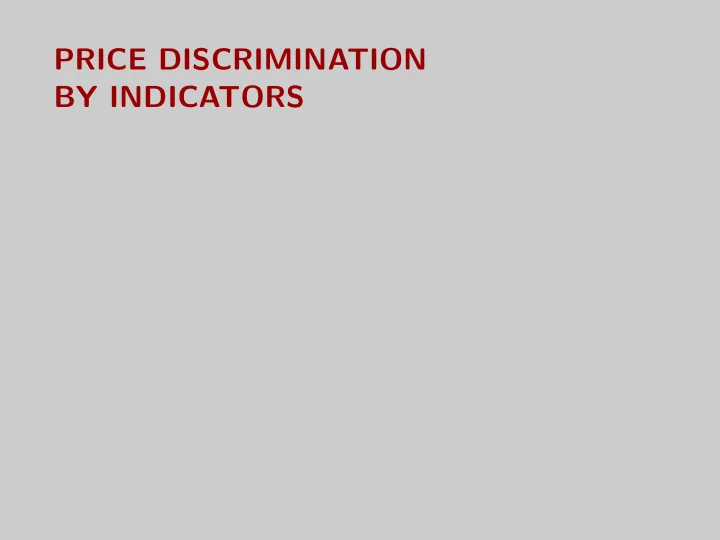

PRICE DISCRIMINATION BY INDICATORS
Overview • Context: Frequently, firms charge different prices to different market segments • Concepts: market segmentation, elasticity rule • Economic principle: If you charge different prices for the same product, expect arbitrage
Motivation p Profit lost to buyers who are willing to pay more than p M . . . . . . . . . . . . . . . . . . . . . . . . . . . . . . . . . . . . . . . . . . . . . . . . . . . . . . . . . . . . . . . . . Profit lost due to consumers . . . . . . . . . . . . . . . . . . . . . . . . . . . . . . . . . . A who do not buy even though there are gains from trade p M . . . . . . . . . . . . . . . . . . . . . . . . . . . . . . . . . . . . . . . . . . . . . . . . . . . . . . . . . . . . . . . . . . . . . . . . . . . . . . . . . . . . MC . . . . . . . . . . . . . . . . . . . . . . . . . . . . . . . B . . . . . . . π . . . . . . . . . . . . . . . . . . . . . . . . . . . . . . . . . . . . . . . . . . . . . . . . . . . . . . . . . . . . . . . . . . . D . . . . . . . . . . . . . . . . . . . . . . . . MR . . . . . . . . . . . . . . . . . . . . . . . . . . . . . q . . . . . . . . . . . . . . . . . . . q M
Example: laptop pricing • Production cost is $1,200 • Three types of buyers: Type W.T.P. ($) No. (K) Cum. No. 1 3000 10 10 2 2000 20 30 3 1000 30 60
Example (cont.) • Strategy 1: Price at $3000 Profit = ($3000 − $1200) × 10K = $18m • Strategy 2: Price at $2000 Profit = ($2000 − $1200) × 30K = $24m • Strategy 3: Price at $3000 for Type 1 Price at $2000 for Type 2 Profit = ($3000 − $1200) × 10K + + ($2000 − $1200) × 20K = $34m • Bottom line: If price discrimination is possible, it pays
Customer markets • In many markets, the number of customers is relatively small and the seller has considerable information about buyers • Examples: ready-mixed concrete, large commercial aircraft, enterprise software, tug boat push services • Although there is a list price (rack rate), each customer receives a discount (often negotiated) • Final price depends on customer’s ability to pay, bargaining power
Perfect price discrimination • Each customer is charged a different price — exactly his/her willingness to pay (“from each, according to his/her willingness”) • Examples: plumber, lawyer, piano teacher; customer markets • With respect to normal pricing, − The seller gains: revenue and profits go up − The low-price buyer often gains − The high-price buyer often loses • Net effect: not clear whether this is good or bad for society as a whole. It depends!
Practical difficulties • Market research: group identification • Arbitrage: resale, gray markets, harvesting • Legal limits, US: injury to competition • Legal limits, EU: single market • Coming next: All approaches to PD are approximations to PPD; we will talk about some possible strategies
Types of price discrimination • Perfect price discrimination • By indicators: market segment can be directly identified − Trick: apply elasticity rule to each market segment • By self-selection: market segment cannot be directly identified − Trick: offer options such that each consumer will pay what they are willing to pay
Discrimination by indicators • Different segments can be identified directly (i.e., it’s easy to know who’s who) • Examples? • Rule: different elasticities ⇒ different prices. Specifically, higher prices in less elastic markets ( elasticity rule ): p i − MC 1 = p i − ǫ i where ǫ i ≡ d q i p i d p i q i
Markups on European cars Model Belgium France Germany Italy UK Fiat Uno 7.6 8.7 9.8 21.7 8.7 Nissan Micra 8.1 23.1 8.9 36.1 12.5 Ford Escort 8.5 9.5 8.9 8.9 11.5 Peugeot 405 9.9 13.4 10.2 9.9 11.6 Mercedes 190 14.3 14.4 17.2 15.6 12.3 • What’s going on here?
Takeaways • Key issues for price discrimination are: − Identifying market segments − Avoiding arbitrage • With clear, separate segments: apply elasticity rule to each separately
Recommend
More recommend